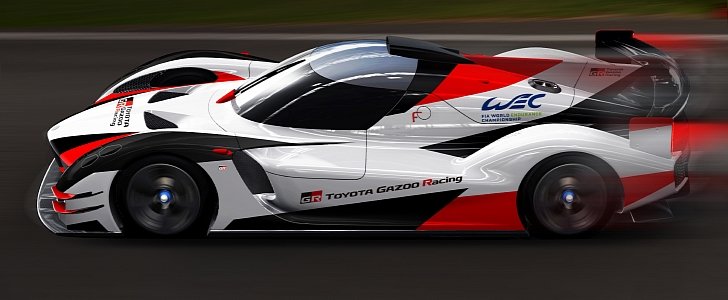Confirmed for production in June 2018, the Toyota hypercar developed with the help of Gazoo Racing will race in the World Endurance Championship starting with the 2020 – 2021 season.
The FIA regulations for the LMP1-replacing hypercar prototype class require every manufacturer to build a minimum of 25 road-going models by the end of the first season, and that amount rises to a minimum of 100 by the end of the second season.
That means Toyota will build no fewer than 100 road-legal units of the hypercar until the second season ends in 2022, which is good news for the automaker’s sporting image. The FIA rulebook also highlights that every road-going car has to feature the internal combustion engine and energy recovery system of the racing car.
Previously limited to 950 horsepower (708 kW), the hypercar class is now limited to 550 kW or 750 horsepower as per the Automobile Club de l'Ouest. As opposed to the current regulations for the LMP1 class, the hypercars are longer (5,000 millimeters instead of 4,650) and wider (2,000 millimeters instead of 1,900). The minimum weight will level up to 1,100 kilograms, making the hypercars heavier than the LMP1 Hybrid prototypes.
Movable aerodynamic devices are allowed, and EVO jokers are limited to five per manufacturer from 2020 until the end of the 2024 – 2025 season. These EVO jokers allow manufacturers such as Toyota to develop their cars without the need to introduce an all-new model in this five-year period.
Aston Martin has also announced its plans for the 2020 – 2021 season in WEC, and the Valkyrie is expected to take the outright win. On the downside, every point accumulated translates to 0.5 kilograms of ballast, onto a maximum weight penalty of 50 kilograms. But on the upside, privateers will have access to drivetrain technology from manufacturers, at a capped cost and performance level.
Turning our attention to the Toyota GR Super Sport Concept, the hybridized hypercar is likely to utilize an evolution of the THS-R system from the TS050 Hybrid prototype. It remains to be seen, however, if Gazoo Racing will soldier on with a twin-turbo V6 as the internal combustion engine.
"For Toyota Gazoo Racing, this new era of competition is a fantastic opportunity to demonstrate our credentials not only as a race team against some of the best in the business, but also as a sports car manufacturer," said Shigeki Tomoyama, president of the motorsports division.
The FIA regulations for the LMP1-replacing hypercar prototype class require every manufacturer to build a minimum of 25 road-going models by the end of the first season, and that amount rises to a minimum of 100 by the end of the second season.
That means Toyota will build no fewer than 100 road-legal units of the hypercar until the second season ends in 2022, which is good news for the automaker’s sporting image. The FIA rulebook also highlights that every road-going car has to feature the internal combustion engine and energy recovery system of the racing car.
Previously limited to 950 horsepower (708 kW), the hypercar class is now limited to 550 kW or 750 horsepower as per the Automobile Club de l'Ouest. As opposed to the current regulations for the LMP1 class, the hypercars are longer (5,000 millimeters instead of 4,650) and wider (2,000 millimeters instead of 1,900). The minimum weight will level up to 1,100 kilograms, making the hypercars heavier than the LMP1 Hybrid prototypes.
Movable aerodynamic devices are allowed, and EVO jokers are limited to five per manufacturer from 2020 until the end of the 2024 – 2025 season. These EVO jokers allow manufacturers such as Toyota to develop their cars without the need to introduce an all-new model in this five-year period.
Aston Martin has also announced its plans for the 2020 – 2021 season in WEC, and the Valkyrie is expected to take the outright win. On the downside, every point accumulated translates to 0.5 kilograms of ballast, onto a maximum weight penalty of 50 kilograms. But on the upside, privateers will have access to drivetrain technology from manufacturers, at a capped cost and performance level.
Turning our attention to the Toyota GR Super Sport Concept, the hybridized hypercar is likely to utilize an evolution of the THS-R system from the TS050 Hybrid prototype. It remains to be seen, however, if Gazoo Racing will soldier on with a twin-turbo V6 as the internal combustion engine.
"For Toyota Gazoo Racing, this new era of competition is a fantastic opportunity to demonstrate our credentials not only as a race team against some of the best in the business, but also as a sports car manufacturer," said Shigeki Tomoyama, president of the motorsports division.








